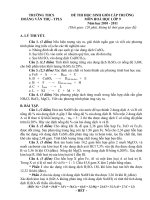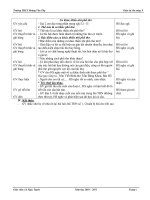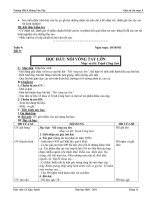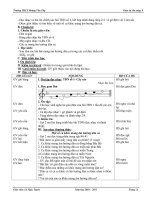trường thcs hoàng xuân hãn
Bạn đang xem bản rút gọn của tài liệu. Xem và tải ngay bản đầy đủ của tài liệu tại đây (142.29 KB, 2 trang )
<span class='text_page_counter'>(1)</span><div class='page_container' data-page=1>
20th Bay Area Mathematical Olympiad
BAMO-8 Exam
February 27, 2018
The time limit for this exam is 4 hours. Your solutions should be clearly written arguments. Merely stating an answer
without any justification will receive little credit. Conversely, a good argument that has a few minor errors may receive
substantial credit.
Please label all pages that you submit for grading with your identification number in the upper-right hand corner, and the
problem number in the upper-left hand corner. Write neatly. If your paper cannot be read, it cannot be graded! Please write
only on one side of each sheet of paper. If your solution to a problem is more than one page long, please staple the pages
together. Even if your solution is less than one page long, please begin each problem on a new sheet of paper.
The five problems below are arranged in roughly increasing order of difficulty. Few, if any, students will solve all the
problems; indeed, solving one problem completely is a fine achievement. We hope that you enjoy the experience of thinking
deeply about mathematics for a few hours, that you find the exam problems interesting, and that you continue to think about
them after the exam is over. Good luck!
Problems A, B, and C are on this side; problems D and E are on the other side.
A Twenty-five people of different heights stand in a 5⇥5 grid of squares, with one person in each square. We know
that each row has a shortest person; suppose Ana is the tallest of these five people. Similarly, we know that each
column has a tallest person; suppose Bev is the shortest of these five people.
Assuming Ana and Bev are not the same person, who is taller: Ana or Bev? Prove that your answer is always
correct.
B A square with sides of length 1 cm is given. There are many different ways to cut the square into four rectangles.
LetSbe the sum of the four rectangles’ perimeters. Describe all possible values ofSwith justification.
C An integercissquare-friendlyif it has the following property: For every integerm, the numberm2<sub>+</sub><sub>18m</sub><sub>+</sub><sub>c</sub><sub>is</sub>
a perfect square. (A perfect square is a number of the formn2<sub>, where</sub><sub>n</sub><sub>is an integer. For example, 49</sub><sub>=</sub><sub>7</sub>2<sub>is a</sub>
perfect square while 46 is not a perfect square. Further, as an example, 6 is not square-friendly because form=2,
we have(2)2<sub>+ (18)(2) +</sub><sub>6</sub><sub>=</sub><sub>46, and 46 is not a perfect square.)</sub>
In fact, exactly one square-friendly integer exists. Show that this is the case by doing the following:
(a) Find a square-friendly integer, and prove that it is square-friendly.
</div>
<span class='text_page_counter'>(2)</span><div class='page_container' data-page=2>
D Let pointsP1,P2,P3, andP4be arranged around a circle in that order. (One possible example is drawn in Diagram
1.) Next draw a line throughP4parallel to P1P2, intersecting the circle again atP5. (If the line happens to be
tangent to the circle, we simply takeP5=P4, as in Diagram 2. In other words, we consider the second intersection
to be the point of tangency again.) Repeat this process twice more, drawing a line throughP5parallel toP2P3,
intersecting the circle again atP6, and finally drawing a line throughP6parallel toP3P4, intersecting the circle
again atP7. Prove thatP7is the same point asP1.
P
1P
<sub>2</sub>P
3P
4P
1P
2P
3P
5=
P
4Diagram 1 Diagram 2
E Suppose that 2002 numbers, each equal to 1 or 1, are written around a circle. For every two adjacent numbers,
their product is taken; it turns out that the sum of all 2002 such products is negative. Prove that the sum of the
original numbers has absolute value less than or equal to 1000. (The absolute value ofxis usually denoted by<sub>|</sub>x<sub>|</sub>.
It is equal toxifx 0, and to xifx<0. For example,<sub>|</sub>6<sub>|</sub>=6,<sub>|</sub>0<sub>|</sub>=0, and<sub>|</sub> 7<sub>|</sub>=7.)
You may keep this exam.Please remember your ID number!Our grading records will use it instead of your name.
You are cordially invited to attend theBAMO 2018 Awards Ceremony, which will be held at the Mathematical Sciences
Research Institute, from 2–4PM on Sunday, March 11 . This event will include a mathematical talk byTadashi Tokieda
(Stanford), refreshments, and the awarding of dozens of prizes. Solutions to the problems above will also be available at
this event. Please check with your proctor and/orbamo.orgfor a more detailed schedule, plus directions.
</div>
<!--links-->









